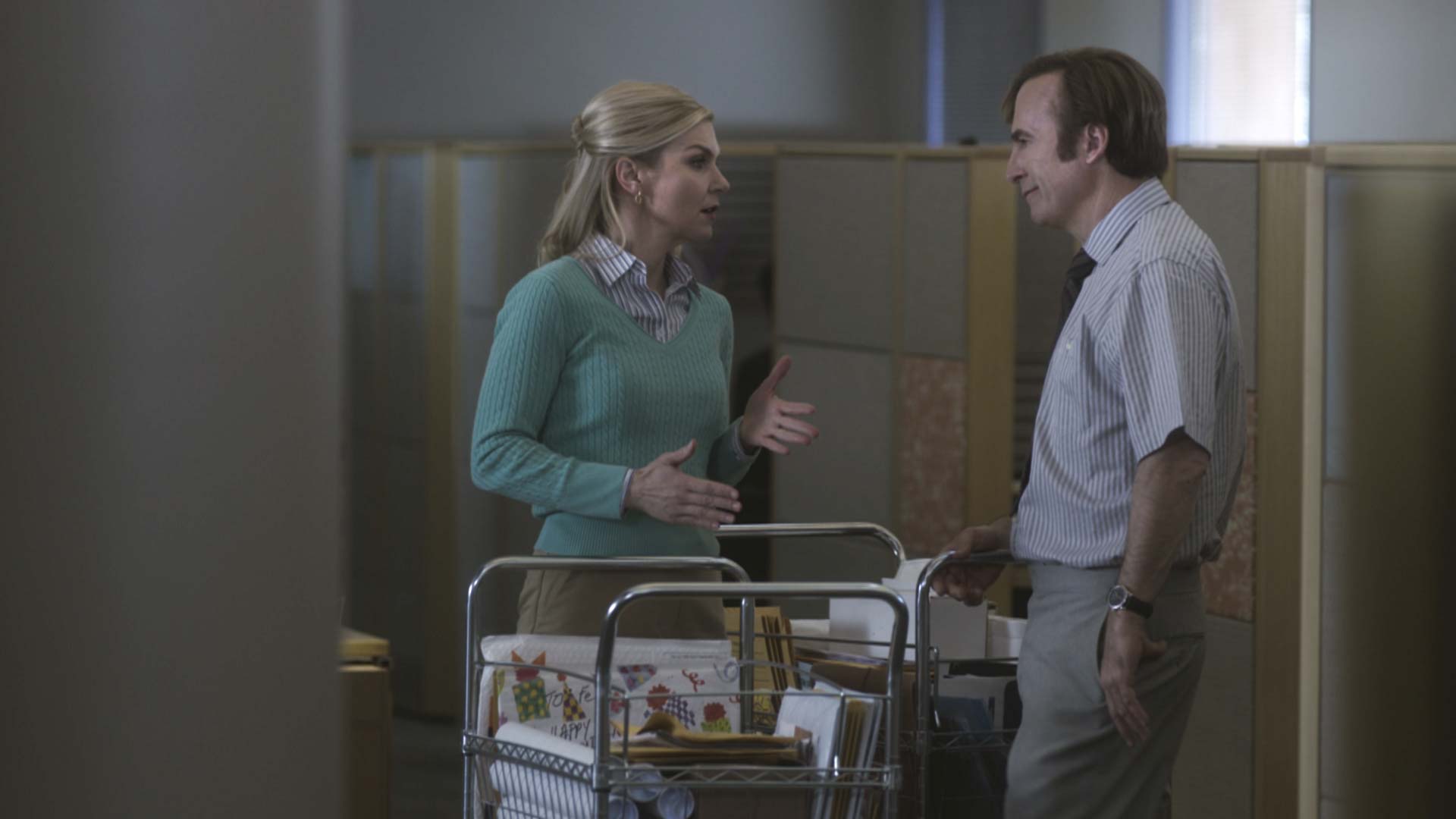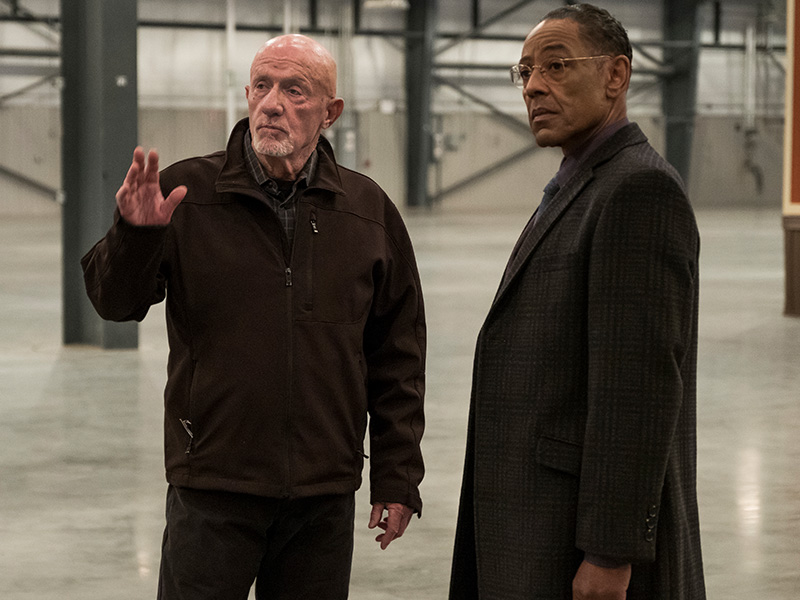Episode six begins to highlight more and more of the impressive writing capabilities of the team behind the show.
Following the season trend, this episode begins to slowly settle the Breaking Bad characters in their comfortable roles that they hold in the original show, with a path that seems to be laid out for a point at which a time jump is inevitable. To elaborate, debut Saul director, Andrew Stanton, emphasises the paths the characters have taken, and it appears as though only time can now develop the paths further.
Throughout the episode, we see Jimmy McGill being pushed to his limit multiple times, which constantly begs to ask if this is the moment that Jimmy will finally “become” Saul. Scrutinisers of the show will realise that this question is meaningless because his transformation into the Saul Goodman person has been happening since the very first episode. Rather than having a distinctive, key moment in which Jimmy ceremoniously decides to become the seedy criminal defense lawyer we all love, Gilligan, Gould and co. have masterfully designed a slow-paced descent into darkness, where the transformation occurs in every episode; every trial and every tribulation Jimmy encounters builds up to his eventual persona. This is how Better Call Saul cements its writing as being far more mature and realistic than Breaking Bad.
In Breaking Bad, there were extremely obvious and distinct moments in the series where Walter’s transformation into Heisenberg was as clear as day. To list a few examples: the famous Crawl Space episode in Season 4 where the once-innocent chemistry teacher finds out that Skyler gave his earnings away to Ted, the scene where he chooses to produce and distribute meth instead of receiving money from his longtime friends, Gretchen and Elliott, or when he utters the famous “I am the one who knocks”. The list is relatively short, however. The contrasting distinction between the two shows is that in Better Call Saul, it’s near-impossible to pin-point an exact moment where Jimmy has “turned into Saul”, because there isn’t. It’s far more realistic here because such a drastic change in character could never be pinned down to one event in one’s life, regardless if you’re a criminal lawyer or a mass meth manufacturer. Nevertheless, the sixth episode begins to make significant strides in propelling Jimmy into his transformation, as well as setting up the various characters in Breaking Bad, namely Gus and Hector.
The episode begins with a flashback in HHM’s office in 1993, which is established cleverly with dialogue referencing the year’s Oscars, namely Emma Thompson’s best actress victory for Howard’s End. Interestingly, we have seen over the past few episodes a literal “Howard’s End” in the helpless downwards spiral of Howard Hamlin’s firm and mental state; we’ll touch on that part of the episode later. Ultimately the reference to Howard’s End is a form of tragedy and comedy that underlines the writing- maybe the writers are foreshadowing the death of Howard? It’s details like these that are chock-full in the episode, which is simply enthralling to piece together and spot. Saul is consistently richly layered with precise details like these, which extends over the cold open into the rest of the episode.

Mike presents Gus with a warehouse seemingly in the middle of nowhere as a home for the Werner-led excavation team, complete with an entertainment system, along with a smorgasbord of various luxuries for the labourers. Gus seems disheartened by the tediousness of the task, to which Mike chides him- Mike retorts that they want to “keep them from climbing the walls”, rather than just “keeping them alive”. Curiously, I find this reminiscent of the professional treatment Walter received in the lab, wherein the meth-making equipment was advanced and perfectly suited for the mass production of the product, which suggests that Werner’s team will eventually play a significant hand of how Gus’ work ethic will develop for Breaking Bad.

Gus is then interrupted by a stone-cold Tyrus, who reports that Hector, who is still in a comatose-state, is struggling to fight off an infection.
The Chilean visits Hector Salamanca in the hospital, relishing in his pathetic disposition. It is here where Giancarlo Esposito delivers his most bone-chilling monologue since his threat to Walter in Crawl Space. Here, he expounds his psychopathic nature to kill, by telling a story of how he nurtured a frail lucuma sapling into a bountiful fruit-bearing tree. Unfortunately, the fruit attracted the unwanted attention of a coati, which would steal the fruit. Gus begins to recount his slow, painstakingly long process of killing the coati, Esposito’s acting skills displaying a beautiful showcase of pauses, emphasis and inflection to remind audiences of the horrifying heights Gus will go to punish those he deems his enemies. The point of the story, however, isn’t to demonstrate Gus’ mentality, but to serve as a mirror to his ideal, torturous methods of making Salamanca suffer. The “fruit-bearing tree” clearly refers to his money-bearing drug empire, with the coati being Hector, an annoying and frankly unwanted creature stealing from the tree. With these elements put together, the full weight of Gus’ intentions with his rival becomes more harrowing to hear.

Next up is Kim, who is offered a lucrative job opportunity in organising Schweikart and Cokely’s new finance division aimed at aiding the rapid expansion plan of the South-Western bank, Mesa Verde. Much to Jimmy’s dismay, who has always wanted to run a partner firm with Kim, Kim tells Jimmy at their favourite bar, at which they performed outrageous cons together earlier in the show, how she is unconditionally accepting the job offer. This is heartbreaking to Jimmy. He excuses himself and stands aside near the kitchen, collecting his thoughts and feeling the tonnage of reality crash down on him. He is pushed to his limits, about to breakdown mentally, but doesn’t. It is here where Bob Odenkirk’s brilliant acting shines, with his destroyed facial express in shallow focus, giving the impression that his complete shift into a self-destructive state is imminent. This is one moment where Jimmy is pushed to his limits.
The other moment comes earlier in the episode, when Jimmy receives a call from the executor of a will from “Mrs. Strauss”, who has been revealed to have passed away in her sleep. Jimmy again maintains his controlled state as he had when Kim had dropped her “bombshell” on Jimmy, until he comes home to watch the commercials they had made with Strauss. Here, the impression that he is on the verge of breaking down into tears becomes very apparent, which is interrupted at the last moment by Kim, who implores him to come over to the bar, where she will eventually give that awful news.
Finally, Howard’s End rings true deep in the third act of the episode, where we see a disheveled Howard Hamlin elaborate on the “rightsizing” of the firm and his troubles dealing with the death of his law partner and McGill’s brother, Chuck. Through a moment of genius subversion, Jimmy chastises him and tells him to fix the firm’s reputation. Howard shouts abuse at Jimmy, who strides out, taking pride in effectively kicking a man while he’s down.
Feasibly, the greatest character change in the show has been, and will be Howard, who has gone from a pompous lawyer sporting his own trademarked colour of indigo blazer, aptly named “Hamlindigo”, to an insomniac, depressed man, wearing a wrinkled, drab black blazer. Howard’s End indeed.

Ultimately, it is in the acting and writing where Better Call Saul shines in episode six, with terrifying performances from Giancarlo Esposito and Bob Odenkirk this time around. The writers have effectively set up the characters on a path that looks like it will lead the characters to their traditional positions, with Hector undoubtedly making a full recovery, Gus starting the creation of his lab, Jimmy continuing his venture in phone sales and Kim building up a finance division in Schweikart.
